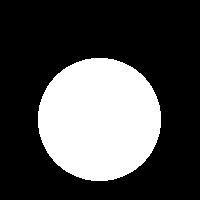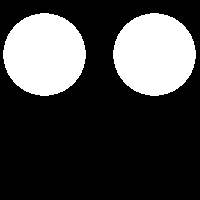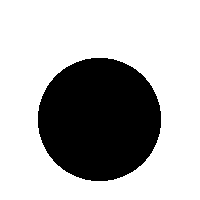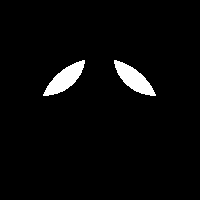Introduction#
Mathematical morphology gathers several techniques that apply to binary images, the latter result for example from thresholding. The pixels in binary images take only two values: 0 or 1, true or false, white or black, etc. In this chapter, we consider that the images contain objects (represented by white pixels) on a background (black pixels), as in Fig. 65.

Fig. 65 Example of a binary image composed of an object (a famous mouse head) on a background.#
The basic operators of mathematical morphology, namely dilation and erosion are first presented. The combination of these two operators allows the definition of new operators, namely opening, closing and the hit-or-miss transform. A comparison of the operators is then presented. At last, we deal with measuring the geometric characteristics of binary objects.
Before beginning, we need to introduce some basic notions.
Set operations#
We also consider that the objects in the image define a set of pixels, so mathematical morphology can use the usual operations on sets, listed below. Consider \(A\) and \(B\) as two sets.
Set \(A\):

Set \(B\):

The complement of \(A\) is denoted \(A^\mathrm{c}\) and is the set of pixels that are not in \(A\):

The union \(A \cup B\) is the set of pixels present in \(A\) or \(B\) or both:

The intersection \(A \cap B\) is the set of pixels present simultaneously in \(A\) and \(B\):

Neighborhood and connectivity#
In a usual image, a pixel at coordinates \((m,n)\) has four horizontal and vertical neighbors whose coordinates are given by
Considering these 4 neighbors, we speak of 4-connectivity (french: 4-connexité).
Besides, there exists also four diagonal pixels with coordinates
These pixels, together with the 4-neighbors, are the 8 neighbors in 8-connectivity (french: 8-connexité).
Fig. 66 The neighbors of the green pixel are represented in red, with 4-connectivity (left) and 8-connectivity (right).#
A path between two pixels with coordinates \((m_1,n_1)\) and \((m_N,n_N)\) is a sequence of pixels such that two consecutive pixels are neighbors in the considered connectivity.
Let \(S\) represent a set of pixels in an image. Two pixels are said to be connected if there exists a path between them consisting entirely of pixels in \(S\).
The set of pixels that are connected is called a connected component (french: composante connexe).
Fig. 67 In this image, there are 2 connected components with 4-connectivity, but only 1 connected component with 8-connectivity.#
Structuring element#
In addition to this, the operators of mathematical morphology need a so-called structuring element (french: élément structurant). A structuring element \(E\) is a set of pixels (equivalent to a binary image) associated with an origin. Generally, the origin is located at the centre of the structuring element; but it may be elsewhere, even outside the pixels of the structuring element. In the sequel, we denote by \(E_c\) the structuring element centred on the pixel \(c\).